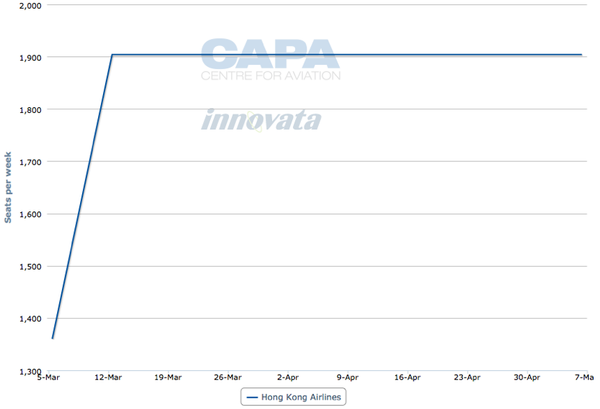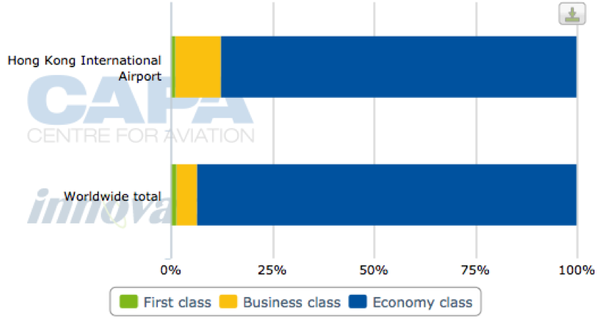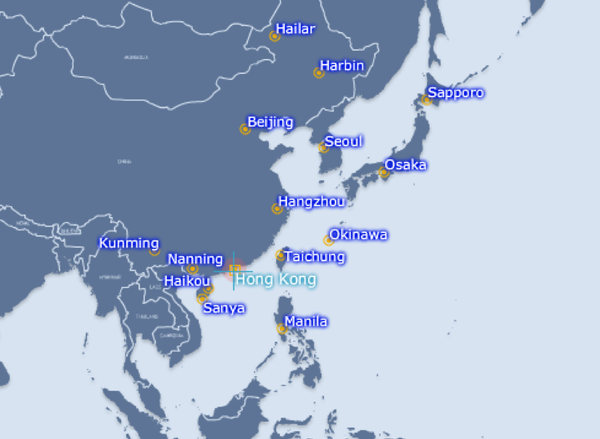Hong Kong Express to re-brand as LCC and switch B737s for A320s as Cathay stands clear of LCCs
Hong Kong is set to receive its first ever short-haul LCC in a move that will see the market further press Cathay Pacific to justify not having a LCC subsidiary. Hong Kong Airlines president Yang Jianhong stated Hong Kong Express Airways will be transformed into an (unnamed) LCC in Jul-2012 or Aug-2012, operating under its new low-cost model to cities in mainland China, South Korea, Japan and Southeast Asia. It will use the traffic rights of Hong Kong Express to Shanghai, Beijing, Singapore, Seoul, Kuala Lumpur, Osaka and Taipei, according to reports in the South China Morning Post.
Mr Yang stated the new carrier will appoint a CEO with European LCC sector experience and will acquire 15 A320s over the next three to four years. Its current fleet of five B737-800s will be transferred to Hong Kong Airlines in 2012. The new LCC will pose a new challenge on lucrative routes from Hong Kong to Beijing, Shanghai and Taipei and opens the door for a pan-Asian carrier like AirAsia or Jetstar to become involved.
Caught in the middle
Hong Kong Express has found itself caught in the middle of the market - a term often held with apprehension in the industry. The carrier was at a competitive disadvantage to the foreign LCCs serving Hong Kong, like AirAsia and Tiger Airways, and forthcoming entrants from the nascent North Asian market. On the full scale end, Hong Kong Express did not come close to matching Cathay Pacific's network and associated benefits like a frequent flyer programme with earn and burn opportunities worldwide. Some of its routes were loss-making.
While Hong Kong Airlines' long-haul operation is very much focussed on the premium sector - it will offer an all-premium service between Hong Kong and London - the carrier has so far proved itself to be interested in origin and destination traffic, eliminating pitfalls of connecting passengers transferring from a full-service carrier to a low-cost one. However, if the two airlines do want to build network traffic, there are examples from hybrid carriers like Qantas' Jetstar and Virgin Australia how service - meals, luggage and frequent flyer points - can be differentiated between passengers.
Jetstar beckons
Jetstar has been looking at ways to establish a subsidiary in Hong Kong, which would necessitate a local majority ownership. Hong Kong Airlines and Hong Kong Express have been targets given their parent owner is Hainan Airlines, the mainland Chinese carrier Qantas has been trying to establish a partnership with and even bring in to oneworld. (Cathay, a member of oneworld, takes a hands-off approach to alliances and cooperates little with Qantas. Cathay has been staunchly against Hainan or Hong Kong Airlines becoming members of oneworld.)
If Jetstar and Hong Kong Airlines could secure approval, a Jetstar Hong Kong subsidiary could be the perfect outcome for both parties. For Hong Kong Airlines, the Jetstar brand is bigger and will mean Hong Kong Airlines will have not have to develop and then establish a separate brand for its LCC. The LCC would also gain from Jetstar's pan-Asian network. Jetstar benefits by having a carrier looking to adopt the LCC model - there are echoes of the 2008 situation between JAL and Jetstar to establish a LCC - who also has local Hong Kong ownership and the critical slot capacity.
The benefits of Hong Kong Airlines adopting a pan-Asian carrier's brand could also be achieved through a partnership with AirAsia or Tiger, the other pan-Asian competitors. Both AirAsia and Tiger would be eager to enter the Hong Kong market and Hong Kong Airlines could be in the driving seat with options to choose from.
A Jetstar-Hong Kong Airlines relationship may push the Qantas-Cathay relationship to a tipping point that sees re-alignment of partners. Cathay is adamant it will remain in oneworld, the alliance it helped to form, but has Star Alliance as a fall-back option as Star carrier Air China has an equity stake in Cathay. Cathay's cooperation with other oneworld members is at a minimum; it competes with British Airways on the premium market to London, has little involvement with American Airlines, and was notably absent when JAL was emerging from bankruptcy - unlike American Airlines and Qantas who worked to help JAL.
Cathay holds firm: No LCC
Cathay Pacific over the past few months has been vocal about the costs of a potential LCC subsidiary outstripping the benefits - dialogue that could indicate Cathay was waiting for Hong Kong Express to change business models.
"We think the focus has to be on what's happening in the market, not establishing a bunch of companies," CEO John Slosar told CAPA earlier this month. China, to use Cathay's mantra, will be the growth story of the decade, and Cathay is positioning itself for the premium traffic that will emerge from the market. It is constructing new lounges, renovating old ones, re-vamped its business class cabin despite the previous seat still being used by other carriers and launching a premium economy cabin for passengers looking to trade up. "Rule number one is don't fight customers," Mr Slosar said. "If they do see value you have to see how to deliver that to them."
Even if Cathay's customers do see value in a LCC, not all LCCs are created equally. In North America where LCC subsidiaries came and went - a situation that causes Mr Slosar to wonder if the Asian wave of LCC subsidiaries is a passing trend - the subsidiaries were flawed from the start. North American LCCs typically offered better service and were of greater appeal to passengers. Consequently when the LCCs were folded up, the parent company ended up absorbing many LCC practices into its legacy network.
The differentiation between the LCC and full-service cost base was little, unlike that between Qantas and Jetstar, who are in the ranks of the few who have successfully created a two-brand strategy. Cathay is closer to Qantas than US carriers in having a premium carrier that it could strip away from to create a LCC. But then brand management and costs become a factor, and Cathay does not see the benefit outweighing costs. Bringing a new brand to market, Mr Slosar said, is a "huge expense".
Cathay benefits from having Dragonair, a full-service subsidiary with a lower cost base than Cathay, enabling the group to better compete in price-sensitive markets or where the competition - like in mainland China - has a much lower cost base.
LCC subsidiaries have almost always been established as a response, not a standalone strategy development. LCC subsidiaries in North America, like Delta's Song and United's Ted, were established in response to the likes of jetBlue. Qantas established Jetstar only after Virgin Blue started eating into its market share. Garuda established Citilink after an influx of LCCs in Indonesia.
Many will point to Singapore Airlines (SIA) making a strong entrance to the full LCC subsidiary arena by launching a low-cost long-haul carrier, furthering pressuring Cathay Pacific to explain why it is completely ignoring the trend. While SIA and Cathay reign as the region's blue-chip carriers, their local markets are very different and explain why SIA needs to follow the LCC path while Cathay does not.
The need to change is not as pressing for Cathay as it is for SIA, who has missed out on growth opportunities over the past decade. More recently, while SIA has been struggling to grow its business under its traditional premium-focused model, Cathay has been quickly able to resume growing its premium business after a temporary setback during the global downturn. If SIA wants to again overtake Cathay as a larger airline group (in terms of total passengers, the SIA-SilkAir combination were bigger in the early portions of last decade than the pre-merger combination of Cathay and Dragonair) it has to diversify and take the risk of assuming a new business model.
Cathay benefits from Hong Kong running out of capacity, meaning Cathay does not face the potential of an influx of homegrown LCCs - as hard as Jetstar and other carriers may try.
Cathay's stance is notably different from that of Qatar Airways, another airline in a premium-heavy region with LCCs knocking on the door. Qatar has boasted it would respond to a LCC threat by establishing its own LCC and could it have operational in a matter of months.
See related articles:
- Cathay explains why it will not follow other Asian carriers in launching an LCC subsidiary or brand
-
SIA's long-haul low-cost subsidiary strategy to restore growth after a lost decade
LCC surge in Northern Asia
At present, 11 LCCs are among the 73 airlines present at Hong Kong. The largest of these is the Philippines' Cebu Pacific with around 15,000 weekly seats, based on Nov-2011 data from Innovata. Cebu Pacific is the 13th largest carrier operating to/from Hong Kong while AirAsia and Tiger Airways are 18th and 29th largest, respectively.
LCCs airlines operating to/from Hong Kong by weekly seats: 21-Nov-2011 to 27-Nov-2011
|
Rank |
Airline |
Total Seats |
|
|---|---|---|---|
|
1 |
5J |
14,784 |
|
|
2 |
AK |
12,600 |
|
|
3 |
TR |
7,560 |
|
|
4 |
FD |
7,560 |
|
|
5 |
3K |
7,200 |
|
|
6 |
OX |
6,202 |
|
|
7 |
9C |
5,916 |
|
|
8 |
7C |
3,760 |
|
|
9 |
HO |
2,740 |
|
|
10 |
2P |
2,478 |
|
|
11 |
BX |
978 |
|
Oasis Hong Kong Airlines made its first flight in Oct-2006 and was as a low-cost long-haul operator, one of the first of its kind. Oasis previously operated from its Hong Kong base to London Gatwick and Vancouver with second-hand B747-400s. Oasis ceased operations in Apr-2008 with accumulated losses of HKD1 billion (USD128 million). The challenges facing the new LCC will be, as expected, the higher operating costs which will arise from operating from the busy Hong Kong Airport, a traditional full service carrier focused hub.
Hong Kong Airlines moves into premium long-haul market
The transformation of Hong Kong Express into an LCC marks a divergence in strategy between Hong Kong Express and its sister carrier, Hong Kong Airlines, both of which are HNA Group subsidiaries.
Fast growing Hong Kong Airlines this month confirmed it would deploy three A330 aircraft on the Hong Kong-London Gatwick sector from 07-Mar-2012, to be operated as a unique all-premium offering. Return fares will start from HK16,640 (USD2136) with a published fare of HKR46,480. Each of the aircraft will showcase two premium cabins: 'Club Premier' and 'Club Classic'. Club Premier will include 34 suites with fully flat 6'1" beds configured 1-2-1 in the two forward cabins. Club Classic will feature 82 cradle seats configured 2-2-2 over two cabins with a 51" seat pitch with 22" width.
According to Innovata data, Hong Kong Airlines will deploy 1904 weekly seats on the Gatwick sector, on which it will be the sole operator. Its service will, however, provide competition for Cathay Pacific, which operates on the Hong Kong-London Heathrow sector, along with British Airways, Virgin Atlantic, Qantas and Air New Zealand.
Hong Kong International Airport to London Gatwick Airport (seats per week, one way, 5-Mar-12 to 12-May-12)
Hong Kong International Airport to London Heathrow Airport (seats per week, one way, 19-Sep-11 to 12-May-12)
Hong Kong Airlines commercial director Wayne Wang stated the carrier decided to enter the Hong Kong-London route with an all-premium product after closely analysing the market, which has an unusually high concentration of business-class passengers due to its link between two key financial hubs. Hong Kong generally has a large portion of corporate and business traffic. Currently 11.2% of all seats out of Hong Kong are business-class seats and 1.3% are first class, compared with a global average of 5.1% and 1.6% respectively.
Hong Kong International Airport schedule by class of seat - one way weekly departing seats (21-Nov-2011 to 27-Nov-2011)
Hong Kong Airlines also plans to launch services to Paris and Sydney, spokeswoman Eva Chan said. However, the carrier has been forced to delay its planned Sydney and Melbourne services due to a breakdown in negotiations between Australia and Hong Kong regarding the increase of traffic rights between the two countries. The carrier, 45% owned by mainland China's Hainan Airlines, planned to launch Hong Kong-Sydney services early next year and Hong Kong-Melbourne services approximately six months later.
Hong Kong Airlines currently operates a fleet of nine A330-200s, having received the first of the type in Jun-2010. As previously reported by CAPA, Hong Kong Airlines will become only the third Asian carrier, after Singapore Airlines and All Nippon Airways, to operate all-premium services and the first carrier to offer an all-premium product between Asia and Europe.
See related articles:
- Traffic rights limitation forces Hong Kong Airlines to delay Sydney and Melbourne services
- Hong Kong Airlines plans A330 all-premium product for Hong Kong-London route
Natural progression of strategy
The divergence between Hong Kong Airlines and Hong Kong Express is part of a continued strategy to differentiate their operations and avoid an overlap in function. The existing strategy and partly-overlapping route structure has created confusion in the market.
Hong Kong Express route network: Nov-2011
Hong Kong Airlines route network: Nov-2011
The need for such a distinction of strategy is particularly relevant ahead of Hong Kong Airlines planned IPO in 2012, as confirmed by Hong Kong Airlines President Yang earlier this year. Mr Yang has estimated the carrier's capital expenditure in 2012 will be approximately HKD8 billion (USD1.0 billion), of which the majority will be used to fund aircraft purchases.
The move into the LCC market also marks a change in strategy from an earlier proposed passenger-cargo split between the two airlines to a premium-LCC orientation. Hong Kong Airlines had previously stated it was completing an equity restructure with sister airline Hong Kong Express Airways to draw a clear distinction between passenger and cargo operations. The carrier previously explained: "The future development of the two carriers will be focused on Hong Kong Airlines. Hong Kong Airlines will mainly operate passenger services and Hong Kong Express will mainly operate cargo services - the latter will no longer be involved in passenger transport". The change in view possibly reflects concerns about the outlook for cargo operations at Hong Kong. Low cost passenger services is clearly a better bet.




